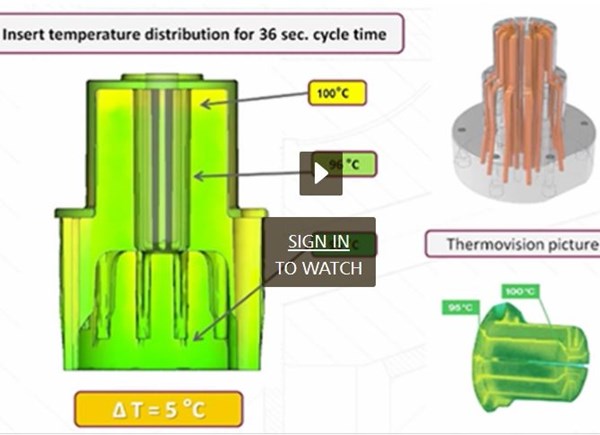Practical Considerations for Conformal Cooling Designs
If you are looking for a comprehensive analysis of cooling design rules for additive manufacturing, check out this webinar.

To run a conformal cooling analysis, the part, conformal cooling channel, and mold must be suitably modeled. The following list is an overview of the steps required.
- Import a CAD representation of the part model and mesh it as either Solid 3D or Dual Domain.
- Select an analysis sequence that includes Cool (FEM). The Study tree is automatically updated to include the steps required to complete this type of analysis.
- Select the plastic material to be used for the part.
- Model the feed system. The minimum requirement is that a single injection location is defined.
- Model any beam element cooling systems that are included in the design.
- Add the conformal cooling channel/s.
- Set both the coolant inlet, and the coolant outlet for the conformal cooling channel.
- Model the mold block.
Note: If importing the mold block, ensure the following steps have been done prior to import.
- The block includes voids where the part and any channel or feed elements are located. This can be done within Autodesk Fusion.
- Simplify the mold block by eliminating any slides, bolts etc. This is best done within the CAD package and will streamline the creation of the mold mesh.
- Create the 3D channel mesh.
- Create the 3D mold mesh. This is a two step process.
- Create a surface mesh of the mold.
- Create the mesh for the volume of the mold.
- Define any required process settings.
- Run the analysis.
Autodesk will present a webinar on April 18th at 10am EST on this comprehensive analysis of cooling design rules, presented in the form of various case studies, with regard to cooling optimization based on additive manufacturing and conformal cooling. The webinar will touch upon part quality and warpage optimization, thermal behavior of inserts (simulation and thermovision analysis), conformal cooling design optimization with regard to flow rates and pressure losses, and maintenance of inserts with conformal cooling.
Click here to register.
Related Content
-
Tolerancing in Mold Design, Part 1: Understanding the Issues of Conventional Bilateral Tolerancing
Mold designers must understand the location, orientation and form limitations of conventional tolerancing before changing to another dimensioning system.
-
Three Good Reasons to Switch from Three- to Five-Axis Machining in Moldmaking
Five-axis machining technology is a great tool in the moldmaker toolbox.
-
What Is Scientific Maintenance? Part 1
Part one of this three-part series explains how to create a scientific maintenance plan based on a toolroom’s current data collection and usage.













